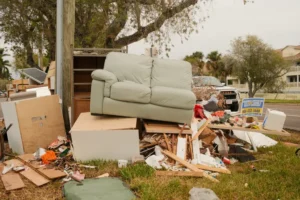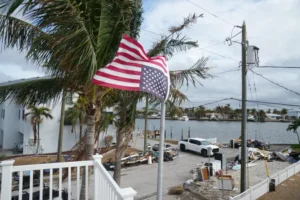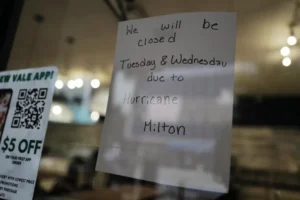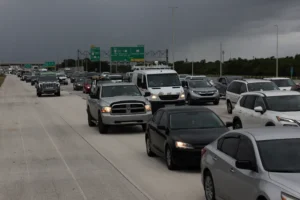As Hurricane Milton moves toward Florida’s Gulf Coast, people are preparing for what experts say could be the worst storm in over 100 years. With huge storm surges and strong winds expected, the region is on high alert, and evacuation orders are being issued.
Hurricane Milton is gaining strength fast, and experts warn it could be one of the most dangerous storms in recent times. Many areas are already vulnerable due to past storms, increasing the risk of widespread damage and flooding.
Evacuation orders are in place, and officials are urging people to take the storm seriously and prepare for life-threatening conditions. Safety is the main focus as the storm approaches, and the next few days will be crucial for those in its path.
### Hurricane Milton: A Record-Breaking Storm
Hurricane Milton has grown into a Category 5 storm, one of the most dangerous types on the Saffir-Simpson scale. With winds over 157 mph, it could cause massive destruction along its path.

The National Hurricane Center warns that homes could be destroyed, trees and power lines will fall, and some places might not be livable for weeks or even months. They said, “A high percentage of framed homes will be destroyed, with total roof failure and wall collapse.”

Storm surges could be especially bad, with water levels rising up to 12 feet in some areas. This could be the worst surge the Tampa Bay area has seen in nearly 100 years. Just weeks ago, Hurricane Helene caused floods with an 8-foot water surge.
Milton is expected to bring even worse flooding. While the storm may weaken to a Category 3 by the time it hits Florida, it will still be dangerous. With winds up to 129 mph, even strong homes could suffer major roof damage, and trees are likely to be uprooted.

Many are comparing Milton to past hurricanes like Irma (2017) and Betsy (1965). But what makes Milton particularly dangerous is the debris left behind by Hurricane Helene, which could worsen the damage.
### Warnings from Officials: The Call to Evacuate
As the hurricane nears, local authorities are giving strong warnings to people in at-risk areas. Tampa Mayor Jane Castor warned, “[If you] stay in one of those evacuation areas, you’re gonna die.”

She said that while past storms like Hurricane Helene were bad, Milton could bring destruction on a whole new level. Pinellas County Sheriff Bob Gualtieri echoed this, calling for the largest evacuation since Hurricane Irma in 2017.
“This is going to be bad. Everyone just needs to get out,” he said. Governor Ron DeSantis also spoke of the risks, saying, “There are areas with a lot of debris… if hit by a major hurricane, it’s going to dramatically increase damage.”

Evacuation orders are in place, and local authorities stress that those who don’t leave will be on their own when the storm hits. Many who stayed behind in past hurricanes are now taking these warnings seriously.
### Evacuation Efforts in Full Swing
With Hurricane Milton approaching Florida’s Gulf Coast, evacuation efforts are in motion. Local authorities have ordered mandatory evacuations for several coastal communities, urging people to leave before it’s too late.

Traffic is heavy on highways as thousands of residents move inland to escape the storm. On Interstate 75, northbound lanes were packed with cars heading toward the Florida Panhandle.
Others sought shelter in places like Fort Lauderdale and Miami, which are expected to be less affected. Meanwhile, southbound lanes were nearly empty. Communities hit hard by past storms aren’t taking chances this time.

In Fort Myers Beach, a town devastated by Hurricane Ian two years ago, streets were empty as residents packed up and left, with only a few people staying behind to secure their homes.
Those who remember the severe flooding caused by Ian’s 15-foot storm surge know the danger is real and are taking steps to avoid a repeat of past tragedies.
As Hurricane Milton nears, people in high-risk areas need to know their evacuation zones and routes. The Florida Division of Emergency Management has a “Know Your Zone” tool, helping residents find their zone by entering their address.

This tool is especially important as evacuation orders continue to come for coastal areas along the Gulf Coast. Several counties are advising residents to check both their evacuation and storm surge zones.
Counties like Hillsborough, Pinellas, Manatee, and Pasco have issued immediate evacuation orders for areas most at risk. Coastal communities in these regions must evacuate quickly.

Other counties, like Polk and Highlands, don’t have mandatory evacuations but recommend sheltering in place. Sarasota, Citrus, and Hernando counties are also monitoring storm surge zones for possible evacuations.
Officials emphasize the importance of knowing your evacuation zone and finding the nearest shelters and safe routes. Those who stay may face the full force of the storm, with emergency services likely unavailable once conditions worsen.

The “Know Your Zone” map offers an easy way for residents to plan their safest escape route. By using this resource and acting quickly, people can protect themselves and their families from Hurricane Milton’s potential devastation.
Celine Dion puts on impromptu performance backstage at the Grammys amid battle with stiff person syndrome

Celine Dion not only shocked everyone by performing unexpectedly backstage at the Grammy Awards, but she also made a surprise appearance to present Album of the Year.
Dion, 55, has maintained a low profile since disclosing her condition in December 2022 in order to combat stiff person syndrome.
In the video, Sonyaé—who is up for a Grammy—and Dion dance to the beautiful harmony of their voices.
The singer of “My Heart Will Go On” made her first appearance in public since November, when she attended an NHL game with her kids. She also made a surprise appearance at the Grammy Awards.
Although there are rumors that Dion’s voice isn’t getting better in a way that would allow her to perform or record again, it appears that she can still hit the notes that we are all familiar with.

After disclosing her illness, she postponed the remainder of her tour dates, raising doubts about her ability to give a complete performance.
Celine, you have our undying love and support.



Leave a Reply